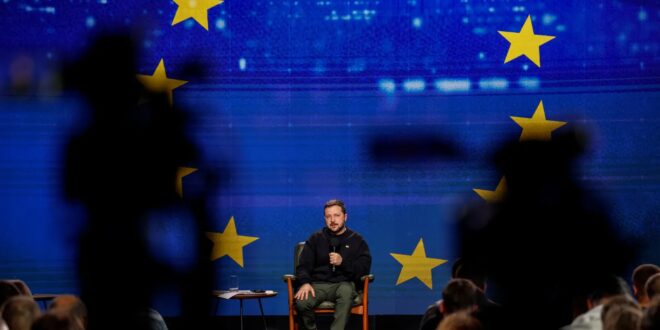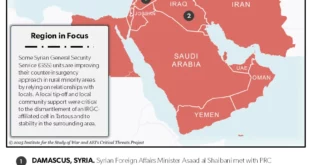And EU and NATO Membership Are the Only Way to Achieve Enduring Security
For Ukraine, December 14 was a tale of two cities. In Brussels, the European Union’s leaders took the historic decision to open talks with Ukraine about joining the organization. For millions of Ukrainians, it was a moment of hope for a brighter future after enduring years of war and hardship. The message was clear: Ukraine belongs at the heart of Europe.
This vision of Ukraine’s future could not have been more different than the one being described by Russian President Vladimir Putin in Moscow on the same day. Responding to pre-screened questions from journalists and handpicked citizens, Putin insisted during a televised press conference that Russia’s political and military aims had not changed since the beginning of the war. Russia has no interest in peace, he made clear, only the subjugation of Ukraine. Putin’s stage-managed affair broadcast the reality of modern-day Russia: a regime built not on democratic legitimacy but on lies and militaristic nationalism, and a government that relies on external conflict to deflect attention from internal failings.
As Putin pushes for a long war, Ukrainian President Volodymyr Zelensky is working for a sustainable peace. Because the consequences of Russia’s invasion have been global—from spiking energy costs to food shortages—Ukrainian officials have been working with counterparts from more than 80 countries to deliver on Ukraine’s “peace formula,” a 10-point plan first proposed by Zelensky in November 2022. On January 14, national security advisers for the leaders of these countries will gather for the fourth time in Davos, Switzerland, to continue elaborating a framework for a lasting and comprehensive peace. We believe that all civilized countries of the world shall support this endeavor.
As long as Putin is in charge, Russia will always threaten not just Ukraine but also the security of all of Europe. It is therefore vital for the democratic world to ensure that a free and independent Ukraine prevails. To do so, it should put in place the security architecture needed to deter a militaristic and imperialistic Russia. If Putin sees the West making strong commitments to Ukraine—through military assistance, accession to the EU, and membership in NATO—he will finally understand that he cannot outlast Kyiv. Only then is there a possibility of a sustainable peace.
STEP ONE: WIN THE WAR
To achieve a lasting peace, Ukraine needs to defeat Russia on the battlefield and restore its territorial integrity, within its internationally recognized borders. For two years, Ukrainian armed forces have heroically resisted Russia’s barbaric invasion. Making good use of Western-supplied weapons, they have managed to reclaim more than 50 percent of the land captured by Russia since February 2022. Meanwhile, the supply of modern air defense systems has dented the effectiveness of Russia’s brutal waves of drone and missile attacks on Ukrainian cities. Ukraine will be forever grateful for the support the democratic world has shown during the country’s darkest hours.
Despite these successes, Russia will not end its war of aggression anytime soon. Its generals will continue to show complete disregard for the lives of their own forces, sending tens of thousands to die in a war of Putin’s choice. Russian and North Korean missiles and Iranian-made drones will continue to target Ukrainian civilians and critical infrastructure.
If military support for Ukraine falters, the consequences will be dire for Europe and the rest of the world. If Putin is allowed to achieve any of his goals in Ukraine, he will not stop there. Russia will threaten more of its neighbors, from Moldova to the Baltic states, and destabilize the globe. Other regional and global powers will take note of his success and use similar tactics to achieve their aims. A Ukrainian defeat would mark the start of the unraveling of the international system. Self-doubt in the West will lead to self-defeating decisions. History shows that appeasing dictators does not lead to peace; it only breeds future conflict. That is why it is essential for Ukraine’s allies to step up their support in 2024 and show that “as long as it takes” also means “as much as it takes.”
As Putin pushes for a long war, Zelensky is working for a sustainable peace.
That philosophy was behind the Kyiv Security Compact we co-authored in 2022. That plan set out key principles for a series of long-term security guarantees that Ukraine needs from its allies to both win the war and prevent future Russian aggression. The compact formed the basis for the joint declaration of support for Ukraine that G-7 countries adopted on the sidelines of the NATO summit in Lithuania last July. As of today, 32 countries have signed on to this joint declaration and are holding consultations on bilateral agreements with Ukraine. These bilateral agreements will ensure that Ukrainian forces have the weapons they need to defeat Russia on the battlefield. Commitments to protect Ukraine over the long term refute Putin’s narrative that Western support for Ukraine is weakening.
Relying on its economic and demographic advantages, Russia is hoping to defeat Ukraine through a war of attrition. Therefore, Ukrainian victory relies on better utilizing the economic and industrial might of the democratic world, which dwarfs that of Russia and its allies. European countries, in particular, need to prepare their defense industries so they can effectively help Ukraine win this war. To do this, they should offer multiyear contracts for weapons, as well as guarantees, to give defense companies the certainty they need to ramp up production. Ukraine also needs its allies’ support in developing its defense industry. Together, the West can vastly outproduce Russia. It just needs to show the political will, so Putin understands that his war is unwinnable and that Russian forces will be driven outside of Ukraine’s internationally recognized borders.
MEMBER OF THE CLUB
In addition to securing the long-term supply of weapons and munitions to Ukraine, it is crucial for Europe and the United States to start putting structures in place to ensure that Russia can never threaten Europe’s security again. Moving Ukraine along its path to EU membership is essential because it provides the political and financial framework for Ukraine to recover and rebuild. A prosperous Ukraine that is part of the EU can act as a bulwark against an autocratic and aggressive Russia. Ideologically, a successful and vibrant democracy in Ukraine is also a strong rebuke of Putin’s autocratic rule.
Membership will bring an added layer of security to Ukraine as well, through the mutual defense clause included in the treaties that govern the EU. This clause states that “if a Member State is the victim of armed aggression on its territory, the other Member States shall have towards it an obligation of aid and assistance by all the means in their power.” The threat of EU member states’ responding directly to future Russian aggression against Ukraine would be a powerful deterrent.
Long-term security guarantees and EU membership would go a long way toward protecting Ukraine, but neither can replace Article 5 of NATO’s founding treaty, which requires members to consider an armed attack against one of them as an attack against all. Bringing Ukraine into NATO remains the best way to bring lasting peace and security in Europe. At the December 14 press conference, Putin stated that Russia launched its invasion—or so called “special operation”—because Ukraine was set to join NATO. But the inverse is true: Russia could only invade Ukraine because it was not covered by NATO’s Article 5.
If at the end of the war, Ukraine is left in the gray zone between Russia and NATO, it will be a recipe for further instability and Russian aggression. This is a reality that both Finland and Sweden quickly recognized. After the February 2022 invasion, both countries saw that in the face of an imperialist Russia, neutrality was no longer an option and that only NATO membership could guarantee their sovereignty. The same goes for Ukraine.
At NATO’s July 2023 summit, members announced that an invitation for Ukraine to join the alliance would be issued only once unspecified “conditions are met.” Ukraine had hoped for something more concrete than that. If Putin believes that Ukraine will be allowed to join NATO only when the fighting ends, it gives him an incentive to continue the war indefinitely. If Ukraine is invited to join the alliance beforehand, however, it could force him to stop.
Although the summit in Vilnius did not present Ukraine with a clear path toward NATO membership, there were positive developments. Members agreed to let Kyiv skip the “membership action plan” part of the traditional accession process, whereby countries submit annual reports about their progress on various security-related metrics. This exemption, which was also granted to Finland and Sweden, should accelerate Ukraine’s eventual accession. In Vilnius, the newly created Ukraine-NATO Council also held its first meeting, and it is already working on bringing Ukraine’s armed forces into alignment with NATO standards.
Still, at this year’s NATO summit in Washington, D.C., in July, the alliance’s leaders would bring the world closer to peace by wholeheartedly embracing Ukrainian membership. The time has come to issue an invitation for Ukraine to join NATO. That does not mean that Ukraine would become a member overnight, but it would send an unequivocal message to Putin that his war is already lost.
 Eurasia Press & News
Eurasia Press & News



